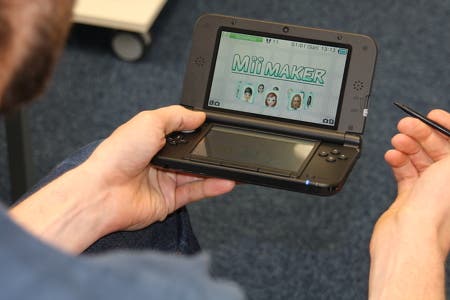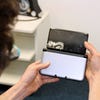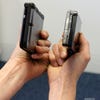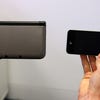Nintendo 3DS XL First Impressions
Nintendo sends us one. We play with it. Is it XL-ent?
The 3DS XL has arrived! It's in the Eurogamer office, anyway, and so am I. Would you like me to steal anything for you while I'm here? I can easily source you a half-empty bottle of Brecon Carreg mineral water or - bit trickier, this - a four-foot tall steel broadsword belonging to the editor, currently buried in a plinth of plastic ice. Nobody's going to miss that.
Or I could just tell you about the 3DS XL, I guess, which touches down in Europe on the 28th. Eurogamer's been sent the silver one, although there will also be red and blue models available, and while this particular unit is earmarked for the DF Hardware team, who will be giving it the whole A-Team dismantling treatment I suspect, probably during a fast-paced montage featuring welding masks and soldering irons, I still had the best part of an afternoon to mess around with it and gather some thoughts together.
Battery life? Performance? Internal hardware changes? No idea whatsoever. DF will fill you in on that stuff, although the official line on the first point, at least, is that it's roughly twice as good as the original 3DS. Nope, I'm covering the softer aspects here: what I think of the buttons, whether it fits snugly in my delicate, doll-like hands, and whether an afternoon of XL Mario has sold me on an upgrade.
Before we get to the machine itself, a word on the box. Ooh! Small! I like it, and so will all the whales that Nintendo will be saving, presumably. How on earth did the big N manage to fit a charger in there along with a larger 3DS unit and that typically gigantic instruction tome?
Oh, they didn't. Thanks, Mario: you've just baffled certain sections of that famous expanded audience - the one that might only just be making the transition from DS to 3DS and may now spend a few quizzical moments pondering whether you charge this new device by - what? - sticking it in a microwave perhaps? Oh, alright, it's not that bad really. The omission feels a little stingy, but the 3DS XL's still compatible with the charger for the 3DS, DSi and DSi XL models. Also, those whales will be happy. They'd better be.
Onto the hardware! The XL's roughly as thick as the 3DS, but because it's bigger - the depth is 93mm, the width is 156mm - it actually feels a little skinnier. Likewise, although it's heavier, weighing in at 336 grams as opposed to the 3DS' 235, you won't really notice the difference unless you're really paying attention.
You will notice the skin of the thing, however, which is matte plastic rather than that glossy stuff that came slapped on the original unit. It's ditched the metallic two-tone paint jobs, as well: the ones that made you feel Nintendo was seconds away from adding alloys, a wicked spoiler, and some undercar lighting.
The device still feels compact and hardy, but the switch in build materials leaves it looking a little cheaper, I think. The MacBook Pro-style sheer black glass stuff surrounding the magical upper screen has been replaced with dull grey plastic, for example; that, together with a switch in styluses (is that the plural of stylus?) to a non-extendable, non-metallic variety, reinforces the sense that the 3DS is a toy.
It's absolutely great to hold, though, which is the only thing that truly matters: its shape is perfect for your hands, and it offers lots of room for your fingers to get a grip around those triggers. It's going to be Howard Hughes' preferred model, too, because it won't pick up greasy thumbprints and get all smeary. (Have I ever told you this country's being invaded by communists and freemasons, by the way?)
The stylus has shifted positions, and is now found stuck halfway down the right side of the device, and the SD slot has switched sides to join it at the bottom right, too, with a tab that is still pleasantly bendy. The various charging, battery and connectivity lights remain in roughly the same positions they always were, but the Wi-Fi light has moved up onto the corner, so you can now see it from the front of the open system as well as from the side. Nice!
The speakers are still found on either side of the upper screen, meanwhile, but they have more vent holes, if that means anything, which I suspect it probably doesn't. My particularly unscientific comparison test suggests they're just as loud as the 3DS, but I think a moth crawled into my ear and died several years back, so let's wait for Digital Foundry to clear that matter up properly (the speakers, not the whole moth thing). What else? Oh yes: the headphone socket remains on the front of the unit, but it's shunted itself to the left a bit. Maybe it had a falling out with the power indicator.

Now, let's talk screens, as that's where the real changes are. And not just in the size, it turns out, although we'll get to that in a minute. I always felt the original 3DS hinge was a little wobbly, see, so I was pleased to discover that the XL's hinge has a lot less give to it. You can click the screen into a few positions, and whatever angle you choose, it's much harder to accidentally shake it out of position.
This hinge business may seem like a small improvement, perhaps, but it's actually my favourite upgrade of the whole device: you can keep the screen soft-locked while upright, for example - great for laying it flat on a desk or table and stabbing at it with a stylus - and it just doesn't feel quite as fragile any more. Also, having had a quick look at the plastic of the housing itself, I reckon DS Lite-styled cracking is very, very unlikely too. Open and shut the thing as much as you want. Open and shut the thing all the live-long day.
Fancy some stats? The stereoscopic screen has switched from 3.53-inches to 4.88, while the touch-screen's leapt from 3 inches to 4.18. Those are diagonal measurements, of course - I'm not a complete tool - but step back from the numbers, and you'll be pleasantly surprised by how much bigger the displays actually are. It's a noticeable size increase when you just pick the device up for the first time; go back to a regular 3DS, meanwhile, and those old units suddenly look a little poky.
The touch-screen is great: it's bright, clear, and the larger area means, I suspect, that Nintendo's had to go for a harder kind of plastic. It certainly doesn't seem to give as much under hammering from the stylus. The top screen, as with the DSi XL, is a bit of a mixed blessing, however. Powering through Rhythm Thief or Super Mario, the 3D effect still looks lovely most of the time - and the bigger screen arguably makes it more of a feature, since it's really filling your entire view now - but if you're hacking away at a game that encourages you to spend a lot of time looking away from the centre of the playing area - at the UI, for example - you're going to notice a touch more image separation than you got with the original 3DS.
As for the question of sharpness, there are rumours going around that there's some kind of filtering going on. I'll leave that sort of thing to DF to uncover, possibly after meeting a mysterious trench-coated secret agent in an underground parking garage at midnight. What I would say now, though, is that it's - understandably - a bit easier to see the individual pixels on the XL, and there's been much discussion in the Eurogamer office whether the screen actually looks a little darker because you can see the black lines separating those pixels. (There was also an argument about what this line is called, by the bye, but I'll spare you that, because I was eating a Mars bar and not really paying attention.)

Ultimately, even with a side-by-side comparison I can't tell whether the screen is darker or not, so if there is a difference, it's very, very slight. As with the DSi XL, though, the larger screen size takes a little getting used to, and leaves you with a sense that the image quality has been quietly compromised. In motion, you're not really going to notice it that much, perhaps, but the jagged edges of, say, a Mario block, look surprisingly pronounced when the action comes to a stop. (Switch to a DS game, however, and, black borders aside, the overall effect isn't as bad as you might have feared, possibly because DS games don't look that great on the 3DS anyway. Fire up the already blurry camera and it's much the same sensation.)
Finally, what about inputs? Motion sensing? No noticeable difference: it's as sharp and responsive as it ever was, and the touch-screen is still wonderfully precise. The d-pad and face controls feel pretty much identical, too, although they're now matte rather than gloss, of course. Fans of Select, Start and Home will be delighted, however: that horrible plastic clicky thing at the bottom of the touch-screen has been replaced with individual buttons, and it feels so much nicer to use.
This brings us to the circle pad, and, yep, although it remains a treat to use, there's still just one of them. I can't decide whether I'm surprised by this or not, but I am a little disappointed. I understand the reasoning, I guess: even if Nintendo did add a second pad, developers would still face a potentially divided market when making true twin-stick games, and many would struggle to justify the risk. Sticking one on would be so much cleaner than meddling with that horrible circle pad peripheral, though, and it would give the core audience a really compelling reason to plump for the XL.
Without a second pad, I think you're left with an update that feels like a missed opportunity for all but those of us whose eyes are starting to pack in, or who travel on planes an awful lot and really want that improved battery life. The XL's a nice upgrade, in other words, but it's hard to argue that it's an essential one for most people. You'll like the hardware, and there are a handful of definite improvements, but it's probably safe to stick with what you've already got.











